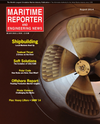
Page 71: of Maritime Reporter Magazine (August 2014)
Shipyard Edition
Read this page in Pdf, Flash or Html5 edition of August 2014 Maritime Reporter Magazine
www.marinelink.com 71have a good solution today, an inexpe- rienced architect can?t create a ship for you. There is a lot of intuition involved in where to put modules, for example, and the ß ow of things, that can?t be au- tomated.?Back to the Future There is a lot on tap for the future. Regardless of software application ? de-sign, construction, ß eet management or operations ? the path is clear. What de- signers, shipyards and ß eet owners want, what they and analysts say are needed, is integration, mobile devices on the production ß oor, simulation and tools to make better use of the collected data.Look for integration on multiple lev-els. Much of the software available to-day is all or partially proprietary. There may be an Autocad link at some point, but the lack of open protocol support is a major headache. Reusability is a key concept in cutting shipbuilding costs, so no one wants to have to rely in data that won?t transfer over, or be forced to print it out on the paper they are trying to leave behind. They also want to be able to pull in and analyze information from multiple sources in order to optimize as much as possible their ship designs and elimi-nate as much as possible mistakes at any point in the supply chain and manufac-turing process. Rework is lost dollars, plain and simple. Paper is still big on the shop ß oor. The way to get away from it is to equip work-ers with mobile devices that they can download job assignments to ? complete with 3D images and assembly informa-tion packets ? and in some cases, point their devices at objects or processes and either launch an activity or get more in-depth ta. No more running over to the paper board and double checking mea-surements. It?s not as expensive as you might think ? business analysts are already talking about a crash in the tablet mar- ket as cell phone makers move to absorb more features into their smart phones, which in turn, will drive down hand-held device costs. It?s also closer than you might think. According to Dassault?s Houard, Japanese ship yards are already deploying mobile devices for production work. Users can expect to see greater use of cloud computing and 3D, even 4D modeling is coming down the pike. Between the capabilities currently available, and the wave of new func-tionality building up down the road, ship designers and builders that are commit-ted to automation can look forward to even greater cost and time savings ? and without compromising the tenets of safe sailing,MR #8 (64-73).indd 71MR #8 (64-73).indd 718/7/2014 10:57:50 AM8/7/2014 10:57:50 AM

 70
70

 72
72
